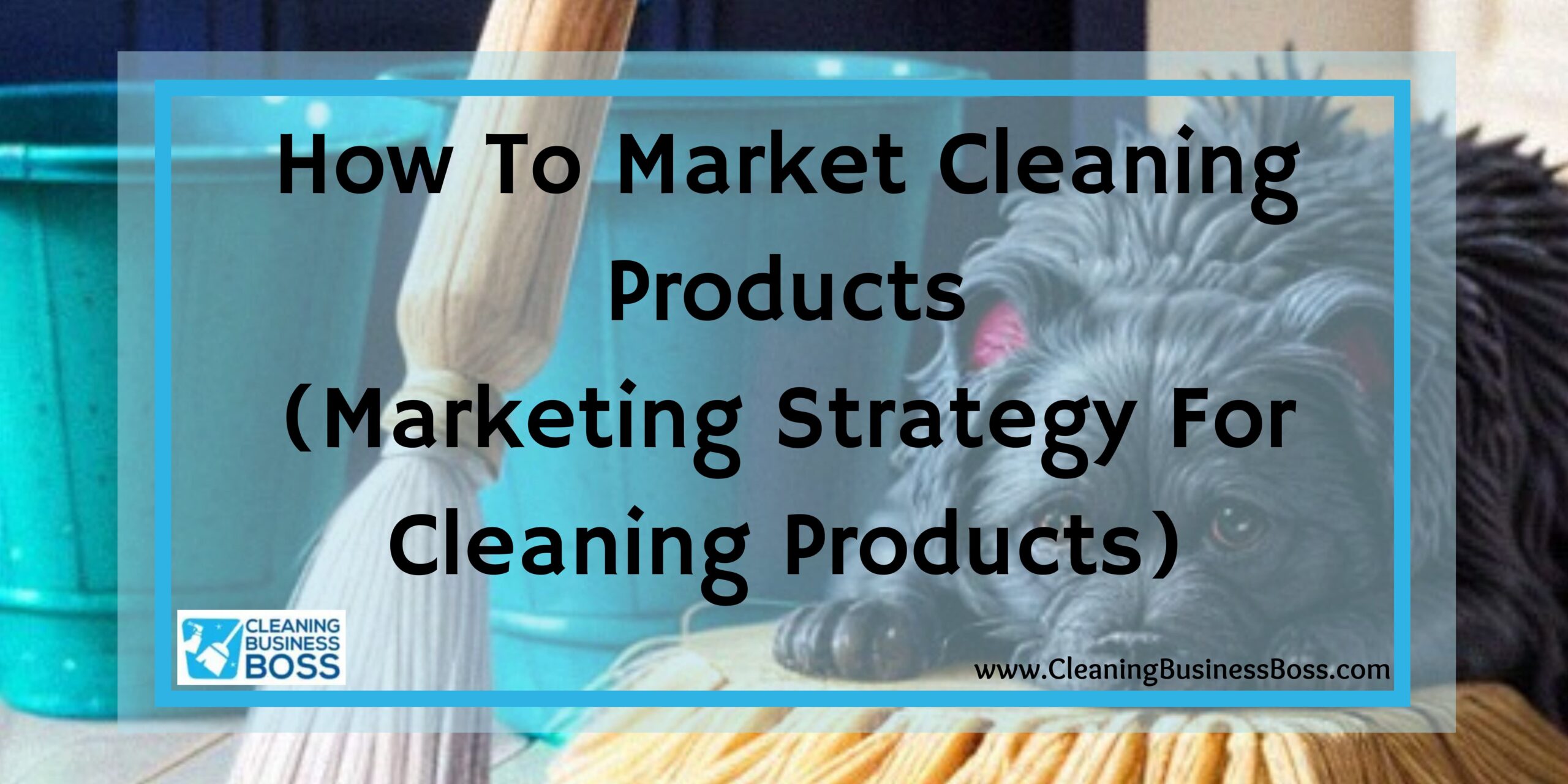Cleaning products are found in practicality every household in America. Whether you need to make sure that your wood is polished; your glass is free of streaks and smudges, or if you need to be sure that your bathtub is sparkling and free of germs, there are cleaning products that are available for every one of your household’s cleaning needs. There are also several multi-purpose or all-in-one cleaners on the market. But, have you ever wondered how you discovered any of these products?
To create an effective marketing strategy for cleaning products, you should follow these steps:
- Make sure to set your cleaning products apart from other cleaning products.
- Set clear sales goals and objectives.
- Use marketing segmentation to find your target audience.
- Develop a multi-channel marketing strategy for your cleaning products.
- Plan your marketing budget.
- Measure and collect your cleaning product sales data.
In this article, I will walk you through these six steps that will help you to develop and implement an effective marketing strategy for your cleaning products. We will also closely examine what advertising methods are most effective when it comes to reaching a target audience for your cleaning products.
Set Your Cleaning Products Apart From Other Cleaning Products
The first step to developing and implementing a highly effective marketing strategy is to take a close look at your cleaning products and see what sets them apart from other cleaning products. Once you have determined what makes your products special and unique, you have found a good marketing angle for your cleaning products. Most people refer to this as a jump-off point. Knowing what makes your cleaning products special is the best place to start because you can plan your entire marketing campaign around this specific feature, or set of features.
Check out this article to get ideas how to get cleaning contracts with offices.
Set Clear Sales Goals and Objectives

Part of a good business plan is setting clear goals and objectives. Your cleaning product’s marketing strategy is no different. This is more than just having a good idea to have an idea of what type of sales figures you want to reach with your cleaning supplies. Your sales goals and objectives should be clear and concise. By knowing where you want your sales numbers to be, you will also know the “who, when, where, and how” of your marketing campaign, because you have already covered the “what” when you determined what sets your product apart from the rest.
Use Marketing Segmentation to Find Your Target Audience
Using marketing segmentation to find the target audience for your cleaning products is one of the most highly effective aspects of your marketing campaign. According to Investopedia, marketing segmentation is defined as identifying a select group of consumers and presenting your cleaning products to them in a way that appeals to their interests. The reason that marketing segmentation is so effective is that it allows you to concentrate your marketing strategy on the group of consumers that are most like Italy to purchase your cleaning supplies. Once you have identified your target audience, you will have a better idea of which channels to use when implementing your marketing strategy.
Develop a Multi-Channel Marketing Strategy for Your Cleaning Products

The marketing strategy of your cleaning products should consist of several channels. I’m sure that you are familiar with the expression, “Don’t put all your eggs in one basket.” That old saying is highly applicable when it comes to marketing. You have several options to market your cleaning supplies, such as social media accounts; television advertising; purchasing ads on YouTube videos, or advertising in newspapers or magazines. Of course, your marketing budget will dictate how many Avenues you will be able to pursue when marketing your cleaning products. The bigger the budget, the more channels you can use for your marketing strategy.
Plan Your Marketing Budget
This is perhaps the easiest part of developing and implementing a good marketing strategy for your company’s products. When you originally wrote your business plan and decided to start a business, part of your original business plan consisted of setting operating expenses. When you determine your operating expenses, part of your budget is allocated towards marketing. The question is, how much money should you spend on marketing and advertising? A good place to start when you are trying to plan a marketing budget is by adhering to the Small Business Administration’s recommended guideline of finding 7 to 8 percent of your gross revenue on marketing, according to Vendux.
Check out this article to know how to get clients for your cleaning business.
Measure and Collect Your Cleaning Products Sales Data

While this may not be the easiest aspect of your marketing strategy, it is certainly one of the easier parts of developing a good marketing campaign for your cleaning products. Once all of the hard work is done, the only thing you have left to do is to sit back, measure, and collect your sales data. These figures will determine whether or not your marketing campaign was a success, and they will also help you to decide which methods of advertising were the most successful when it comes to selling your cleaning products. Now that you have this data on hand, it should be easy for you to figure out your marketing strategy for other products or supplies.
Summary
The world is a dirty place. You offer products that can make it cleaner. Seems like a match made in Heaven, doesn’t it? With the implementation of an effective marketing strategy, your cleaning product sales can skyrocket. First, you have to set your cleaning products apart from other cleaning products. Next, you need to make sure that your sales goals and objectives are clear. After this, you need to employ the use of marketing segmentation to find your target audience. Once you have found that audience, you will have to develop a multi-channel marketing strategy. The next step will be to plan your marketing budget.
After you have finished these steps, you need to measure and collect your sales data. While these steps may initially seem to be a bit tedious, you need to be patient and see your plan to the end. Once you have successfully followed these steps to marketing your cleaning products, your reward will be an increased bottom line because your cleaning products are flying off the shelves. This is all due to your effective marketing strategy, and you will be on your way to making this dirty world a cleaner place to live.
Frequently Asked Questions
Are cleaning products that are labeled as all-natural as effective as other cleaning products?
For a long time, many cleaning products that are labeled as all-natural were not as effective at cleaning as products that contained harsh chemicals. However, that has changed over the past few years. Now, many cleaning products are going the natural route, choosing to use fewer harsh chemicals in their cleaning products. These products use ingredients such as vinegar or lemon juice instead of ammonia and are just as effective at cleaning as older products.
What are a few tips and tricks to getting your home as clean as possible?
There are several different tips and tricks that you can use to make your home a cleaner place. Many of them use products that can be found around the home. You can use baking soda to remove rust from your kitchen sink. If you happen to get stains on your carpet, baby wipes can help lift the stains out. A good squirt of WD-40 is great for getting crayon marks off of your walls without damaging your paint. Finally, dishwashing liquid can help with toilet clogging issues.
To learn more on how to start your own cleaning business, check out my startup documents here.
Please note that the contents of this blog are for informational and entertainment purposes only and should not be construed as legal advice. Any action taken based on the information provided in this blog is solely at your own risk. Additionally, all images used in this blog are generated under the CC0 license of Creative Commons, which means they are free to use for any purpose without attribution.

About the author. Entrepreneur and Cleaning Business Fan.
Hi! I am Shawn and I am a happy individual who happens to be an entrepreneur. I have owned several types of businesses in my life from a coffee shop to an import and export business to an online review business plus a few more and now I create online cleaning business resources for those interested in starting new ventures. It’s demanding work but I love it. I do it for those passionate about their business and their goals. That’s why when I meet a cleaning business owner, I see myself. I know how hard the struggle is to retain clients, find good employees and keep the business growing all while trying to stay competitive.
That’s why I created Cleaning Business Boss: I want to help cleaning business owners like you build a thriving business that brings you endless joy and supports your ideal lifestyle.

